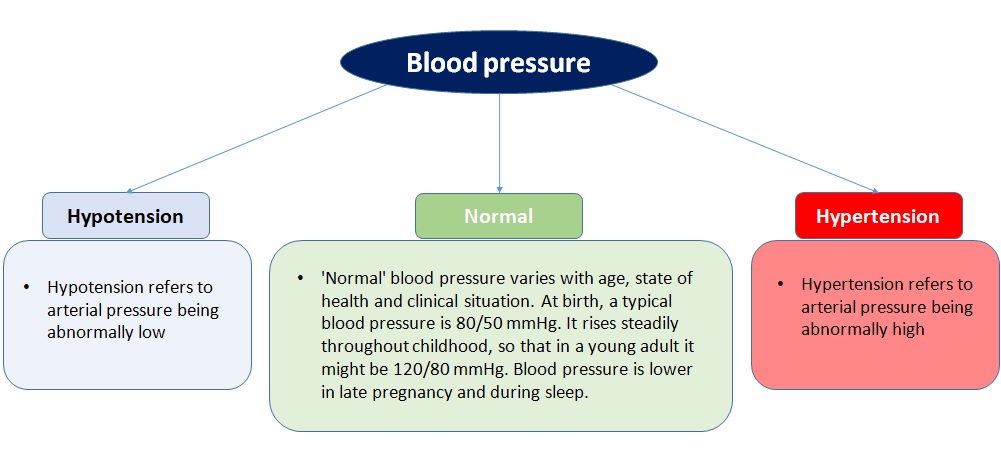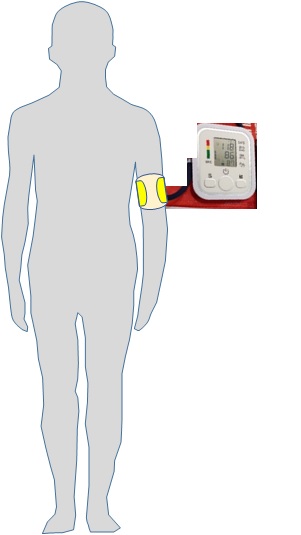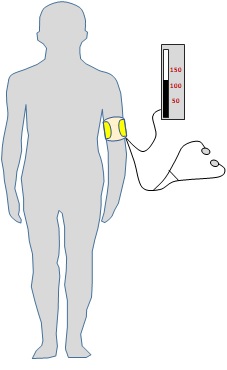NIBP
What is BP?
- Blood pressure (BP) is the force exerted by circulating blood on the walls of blood vessels.
- It constitutes one of the principal vital signs.
- The term blood pressure generally refers to arterial pressure. (The pressure of the circulating blood decreases as blood moves through arteries, arterioles, capillaries, and veins)
- Blood pressure values are reported in millimetres of mercury (mmHg).
- For each heartbeat, blood pressure varies between systolic and diastolic pressures.
- Systolic pressure is a peak pressure in the arteries, which occurs near the beginning of the cardiac cycle when the ventricles are contracting.
- Diastolic pressure is minimum pressure in the arteries, which occurs near the end of the cardiac cycle when the ventricles are filled with blood.
- An example of normal measured values for a resting, healthy adult human is 115-120 mmHg systolic and 75-80 mmHg diastolic (written as 115/75 mmHg).

IBP(IAP) Vs. NIBP(NBP)
Blood pressure monitoring is essential in managing hemo-dynamically unstable critical care patients.
- Invasive measurement from an arterial line (invasive arterial blood pressure [IAP]) is generally considered to be the gold standard
- Automated noninvasive blood pressure systems (NIBP) usually using oscillometric techniques have advantages over invasive arterial lines as they avoid bleeding and infection risk, and can be used outside the care unit.
NIBP
Noninvasive BP measurement involves placing a cuff around a limb to compress an artery. Methods of NIBP determination include:
- Auscultation
- Doppler ultrasound
- Oscillometry (frequently used in automatic machine)
Non-invasive blood pressure measurements are quick and simple to do, and cause minimum stress to the patient.

Auscultation and Doppler ultrasound
Auscultatory (Manual Cuff)
- Useing a sphygmomanometer and an occluding cuff and a sound detector or a stethoscope over the occluded artery to detect the sound which is emitted as the cuff is deflated.
- The cuff pressure at which the sound is first emitted indicates the systolic pressure. When the sound disappears, or when the sound quality changes, the cuff pressure is approximately equal to the diastolic pressure.
Auscultation Assisted with Doppler Flow Detectors
- This technique requires a sphygmomanometer and a handheld Doppler device. The pulse detector is placed over the brachial or radial artery distal to the cuff and the characteristic hushing sound (shhh, shhh, shhh) signifying blood flow and vascular motion, is listened for as cuff pressure is reduced.
- The pressure at which the first hushing sound is heard is recorded as the systolic pressure. The hushing sounds continue as long as the device is held over the open artery.

Oscillometry
- Oscillometric devices measure the amplitude of pressure changes in the occluding cuff as the cuff is deflated from above systolic pressure. The amplitude suddenly increases as the pulse breaks through the occlusion in the artery. The pressure at which this occurs is very close to the systolic pressure. As the cuff pressure is decreased further, the pulsations increase in amplitude, reach a maximum (which approximates to the mean pressure), and then diminish rapidly. The index of diastolic pressure is taken where this rapid transition begins.
- They measure systolic and diastolic pressures by oscillometric detection, using a piezoelectric pressure sensor and electronic components, including a microprocessor. They do not measure systolic and diastolic pressures directly, but calculate them from the mean pressure and empirical statistical oscillometric parameters
- Some advantages of oscillometry over the auscultatory method are lack of observer variation, accuracy, the ability to take an NIBP on a cycled time without disturbing the child, and the simultaneous display of pulse rate.
